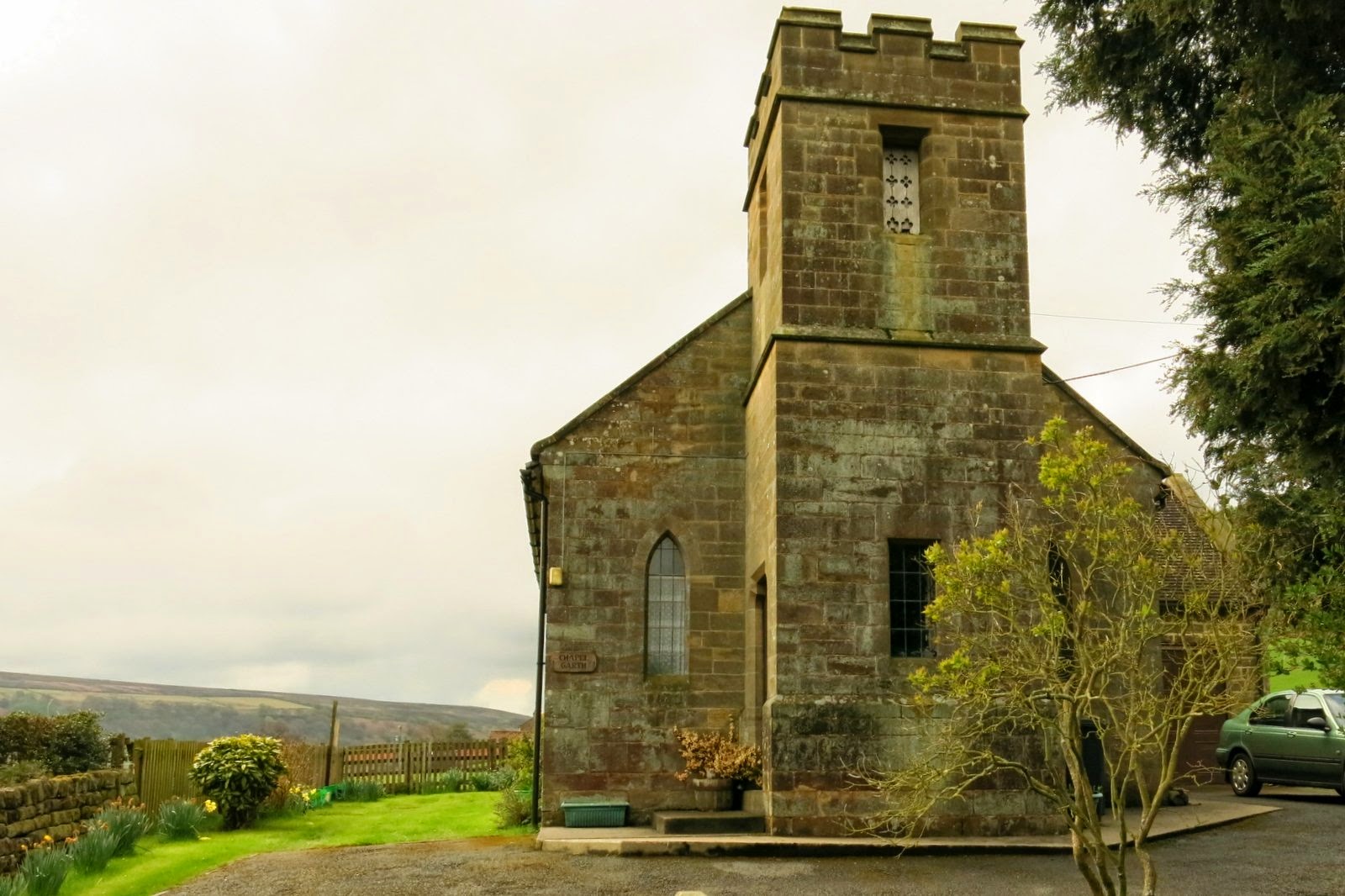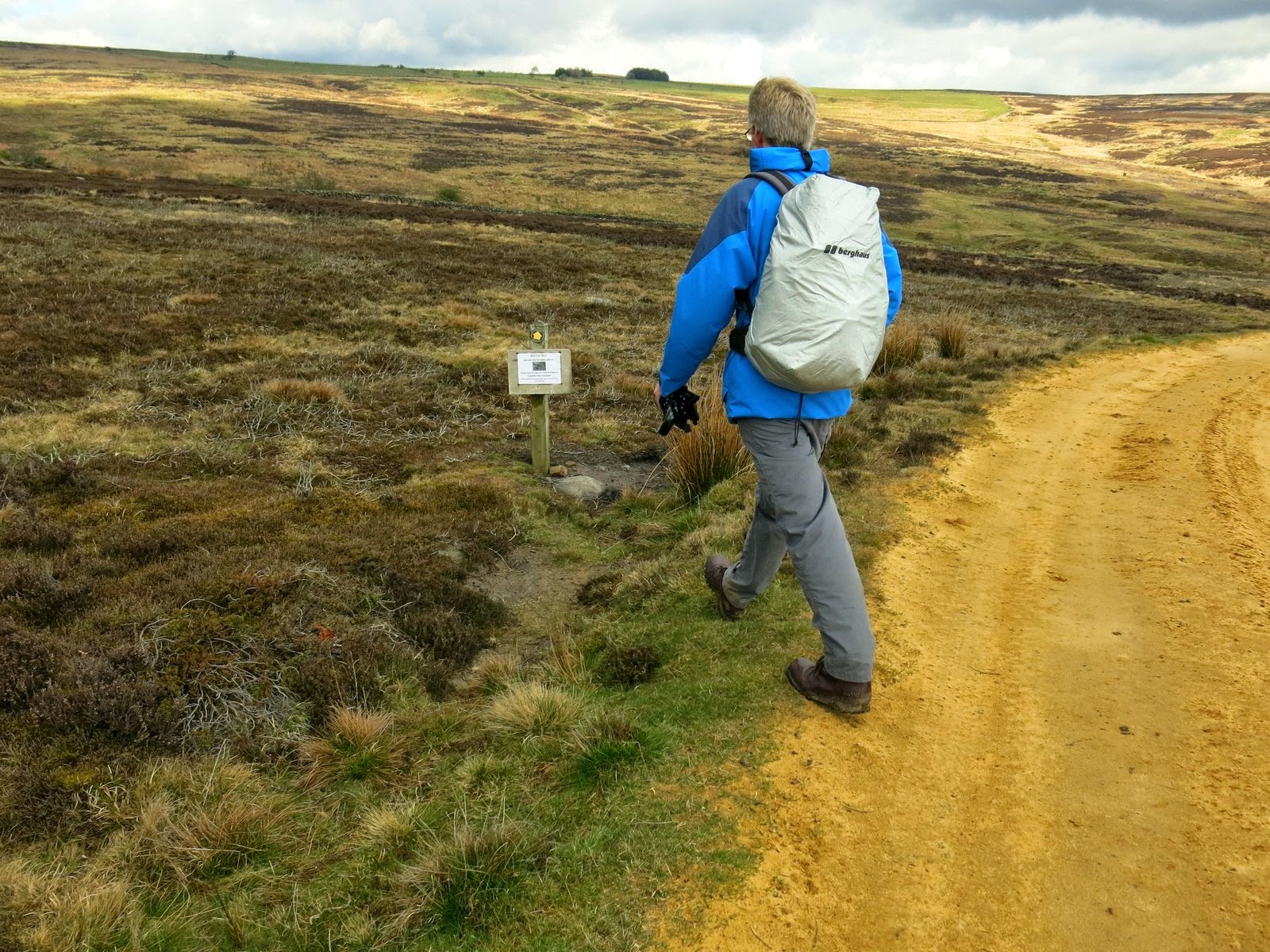Ladhill Gill and Bumper Castle from
Fangdale Beck
7.5 miles Cool with April showers
We turned off the B1257 Bilsdale Road
and drove past an old green telephone kiosk to the village of Fangdale
Beck where we parked at the roadside. Tom Scott Burns tells us that Fangdale comes from the personal Scandinavian name Fangi or Fangulf, giving 'Fangi's Valley'. Leaving the car we crossed the beck by the little bridge and walked past the old Wesleyan Chapel, now converted into a private house.
 |
| Today's walk from the Walker's Guide to the Cleveland Hills |
 |
| Converted chapel |
 |
| Looking back at Fangdale from Malkin Bower |
A walk along a farm track brought us to a farm called Malkin Bower, which apparently means Matilda's or Maud's Dwelling. Opposite the farmhouse was a barn containing sheep and newly born lambs, all looking very comfortable.
 |
| Malkin Bower |
 |
| Dog weathervane at Malkin Bower |
 |
| New lambs |
 |
| "I'll just have that bit on the very top.." |
Once past the farm the tarmac vanished
and we followed the path along the valley of
Bilsdale, parallel to the road below us. The track dropped down to the
River Seph before climbing gently up to Helm
House where we admired a couple of very old tractors and a road roller, all gently decaying but ripe for renovation.
 |
| Today's walk is little used and we relied on way-marks rather than paths |
 |
| Old tractor... |
 |
| and roller at Helm Farm |
Leaving the farm we crossed several sheep fields until we approached a gate just before a forest plantation. We could see a sheep and lambs at the gate but as we approached it became apparent that a tragedy had occurred and the lambs were now orphans. We looked round but there was no sign of anyone to tell, and we watched as the lambs ran to other sheep who gently butted them away. There was nothing for it but to return to Helm Farm which, including a return to this spot, would add another 1.5 miles to our walk. At Helm House we reported the fallen sheep to the farmer who said he would sort it out straight away.
 |
| Leaving Helm House |
 |
| Fine Hawthorn Blossom |
 |
| Hmm, this looks like trouble! |
 |
| A sad sight |
 |
| Hungry orphans |
 |
| Back to Helm House! |
Passing by the orphans once more and reassured to think that help was on the way, we started the half mile climb of Benhill Bank at the top of which we turned sharp right onto tarmac. After a couple of hundred yards our track bore left off the tarmac across fields and we continued to climb onto the moor.
 |
| Benhill Bank |
 |
| This guy watched us walk by just two feet away but couldn't be bothered to fly off |
 |
| Clive (and lamb) watch in amazement as fearless pheasant struts away |
 |
| Our first sight of Easterside Hill from Benhill Bank |
 |
| We reach the moor gate |
The last gate took us to the moor edge
where the path became more distinct. Looking
down to our right we saw the ruins of Bumper Castle behind a grove of
trees and difficult to get to from our position. TSB tells us that the castle was at one time part of the estate of the
Duke of Buckingham and also that the monks of Rievaulx once wrought iron
on Bumper Moor. We met another track leading straight down to the
valley bottom and Ladhill Gill. Reaching the stream we sat on some
convenient rocks for our usual coffee and scones, sitting for a few minutes in sunshine before black clouds approached and hail bounced off us, splashing in our coffee.
 |
| There was no obvious path across the moor |
 |
| The remains of Bumper Castle |
 |
| Looking across at Sportsmans Hall |
 |
| Heading down to the river, Sportsmans Hall opposite |
 |
| Gated bridge over Ladhill Gill |
 |
| Ladhill Gill from our coffee stop |
A stiff climb took us up to Sportsmans Hall which TSB suspects is so called because of a past
link to the sporting activities of Bumper Castle, but the Hall now appears to
be a working farm. Our path skirted above the Hall and we reached a tarmac road, turning right at the Moor Gate to walk to the information board and
car park at Arden Moor.
 |
| Stiff climb from Ladhill Gill |
 |
| Looking across at Shaw Side, boulders on the slope glistening in the sun |
 |
| Entering Arden Moor |
We turned right at the information board
and walked along the vehicle track for a mile or so until we took a
right fork to walk back down towards Wetherhouse Beck. At this point we met a couple of hikers and stopped for ten minutes to chat about our respective walks. Walking on, we
left all signs of designated footpath behind and crossed a large boggy area always
looking out for the occasional yellow way-mark until we crossed Wetherhouse Beck and
climbed across rough ground. We reached a drystone wall which we
followed until we gained the moor top.
 |
| Loking back to Easterside Hill and Hawnby Hill |
 |
| Bear right at the fork |
 |
| We meet a couple of hikers, a spinone and a border terrier |
 |
| The shepherd passes, his crook in a neat holster attachment |
As we crossed this moor we saw the remains of a pigeon, both legs ringed, which had obviously been struck by a hawk. Clive, a pigeon fancier, explained that the code on the red ring showed the bird was from the North West and the blue ring contained a chip that would activate a timer when the bird returned, showing its race time. The red ring showed 2015 and the season only started a couple of weeks ago so Clive took the rings to inform the owner of the bird's fate.
 |
| Our path turns onto open moor |
 |
| Once a racing pigeon |
From the moor top we looked down into Bilsdale
and the village of Fangdale. Our path passed through a gate and then went steeply downhill by some old quarry workings, eventually emerging at
Malkin Bower Farm where we turned left to walk back to our start point
in Fangdale.
 |
| Crossing open moor |
 |
| Down past old quarries |
 |
| The path leads directly to Malkin Bower |
 |
| Fangdale |
 |
| Entering Fangdale |
